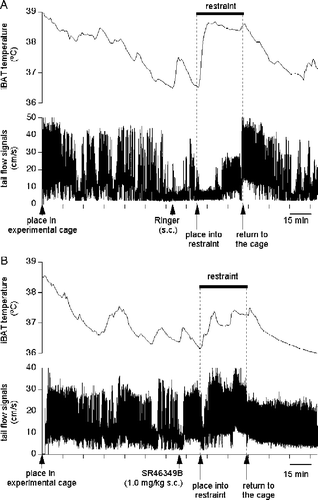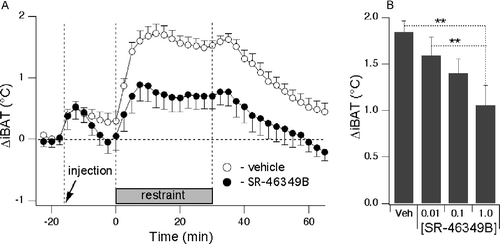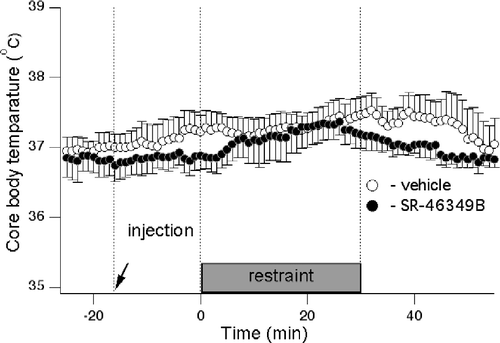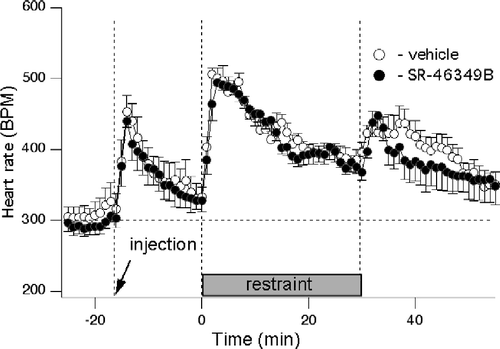Figures & data
Figure 1 Restraint stress causes changes in the iBAT temperature (upper traces in each panel) and in the tail blood flow (bottom traces); both records are from the same rat on different days. In (A), vehicle was injected s.c. 15 min prior to the restraint; in (B), restraint was preceded by injection of SR-46349B at a high dose (1 mg/kg s.c.). SR-46349B attenuated the increase in iBAT temperature and the decrease in tail blood flow during restraint.

Figure 2 Blockade of 5-HT2A receptors with SR-46349B attenuates the stress-induced increase in iBAT temperature. Mean group data are expressed as delta values. (A) Averaged traces from 8 rats obtained after injection of either vehicle (○) or SR-46349B at a dose of 1 mg/kg (•) 15 min prior to the restraint. There was a significant difference (p < 0.01, n = 8) in the increase in iBAT temperature between vehicle and drug conditions. (B) mean values for stress-induced changes in the iBAT temperature for 4 different conditions (vehicle or SR-46349B at doses of 0.01, 0.1 and 1.0 mg/kg s.c.). **Significantly different, p < 0.01, respectively. Data are expressed as difference between basal (pre-injection) values and maximal temperature increases during restraint.

Figure 3 Blockade of 5-HT2A receptors with SR-46349B attenuates stress-induced transient decreases in tail blood flow. (A) averaged traces from 8 rats obtained after injection of either vehicle (○) or SR-46349B at a dose of 1 mg/kg (•) 15 min prior to the restraint. There was a significant difference between vehicle and drug conditions during the first 5 min of restraint (p < 0.01, n = 8). (B) Mean data values obtained during the baseline period (Bas) are compared to the mean data values obtained during the first 5 min of the restraint, for 4 different conditions (vehicle or SR-46349B at doses of 0.01, 0.1 and 1.0 mg/kg s.c.). Restraint provoked significant decreases in the tail blood flow only after vehicle and the low dose of the drug (* and ** significantly different, p < 0.05 and < 0.01, respectively).

Table I. Effects of SR-46349B on the tail blood flow before and during restraint.
Figure 4 Core body temperature is not affected by SR-46349B nor by the restraint stress. Averaged traces from 7 rats obtained after injection of either vehicle (○) or SR-46349B at a dose of 1 mg/kg (•) 15 min prior to restraint. Two-way ANOVA did not reveal any significant effects of either treatment or restraint on the core body temperature.

Figure 5 Blockade of 5-HT receptors with SR-46349B does not affect tachycardia elicited by the restraint stress. Averaged traces from 7 rats obtained after injection of either vehicle (○) or SR-46349B at a dose of 1 mg/kg (•) 15 min prior to the restraint. Heart rate was significantly elevated following vehicle or drug injection and during restraint compared to the baseline. There was no significant effect of SR46349B.
